New York is home to an array of diverse varieties of fungi, many of which are edible and safe to forage. Here are a few of the many types that can be found around the state!
Disclaimer
This article does not describe the details needed to thoroughly identify these mushrooms. Deadly and otherwise toxic look-a-likes do exist and may even be common in your area. Before foraging for any mushroom please spend the time to thoroughly Identify the mushroom using multiple sources.
Chicken of the Woods (Laetiporus sulphureus)
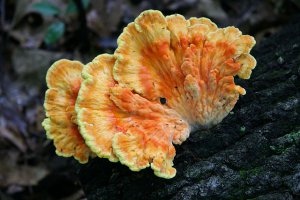
Chicken of the Woods is a particularly easy-to-spot mushroom in the wild, as this mushroom has a vibrant orange color. Chicken of the Woods is also known as Sulphur Shelf, as it resembles a shelf-like structure. However, Chicken of the Woods was named based on its texture and flavor, which has been described to resemble chicken meat. This mushroom often reaches two to 10 inches in width and can weigh over 100 pounds. It is most commonly found on decaying or dead oak trees and is best harvested from spring to autumn.
Hen of the Woods (Grifola Frondosa)
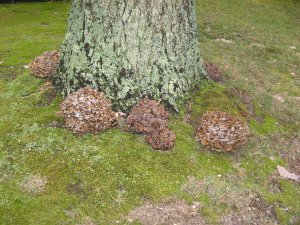
Hen of the Woods is also known as Sheep’s Head mushroom or Ram’s Head mushroom. Hen of the Woods predominantly grows in older forests, at the base of oak trees mostly, and in northern climates near bodies of water. This mushroom is brown or grey with white edges, with flat or ruffled caps, reaching between four and 36 inches wide and two or three feet tall. They can even weigh up to 30 pounds! Autumn is the best time to forage Hen of the Woods.
Giant Puffball (Calvatia gigantea)
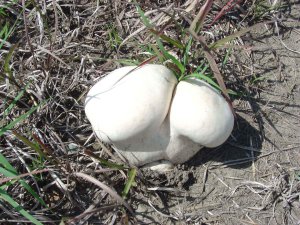
Puffball mushrooms are some of the most commonly thought of varieties when someone thinks of a mushroom, and the Giant Puffball is one common variety found in fields, meadows, and deciduous forests. These mushrooms can reach between four and 20 inches in size and can weigh over 40 points, developing only within a few weeks. The best time to search for the Giant Puffball mushroom is in the late summer and autumn seasons. Be cautious of its poisonous lookalike, the Earthball mushroom. The Giant Puffball mushroom is safe to eat when the inside is fully white, but take caution to avoid Young Deathcap mushrooms, which look similar on the outside, but have outlines of gills inside.
Golden Chanterelle (Cantherallus cibarius)
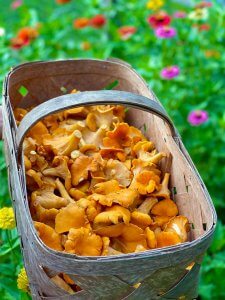
Another bold yellow-orange mushroom is the Golden Chanterelle. This funnel-shaped mushroom grows underneath live oak trees, sprouting from the soil alongside the trunk, from late June to early August. Golden Chanterelle mushrooms have a curved stalk and a smooth texture. The cap reaches between a half-inch and six inches, with the stalk averaging one to three inches tall. When searching for this mushroom, be aware of its poisonous lookalike, the Jack O Lantern mushroom, or the Omphalotus illudens.
Oyster Mushroom (Pleurotus ostreatus)
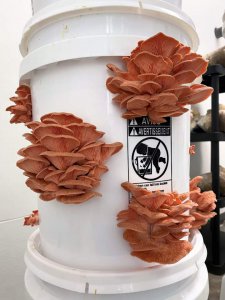
The Oyster mushroom is another variety of fungi named for its appearance, as the body resembles an oyster shell with decurrent gills that directly run from the stem. Oyster mushrooms range from white to light brown in color and often grow on deciduous hardwoods, including beech and aspen trees. The cap of this mushroom often reaches between two and 10 inches across in a shelf-like formation. It is also another type of saprotrophic mushroom, which grows from dying or dead trees commonly during the summer and fall seasons. Aside from appearance, oyster mushrooms often omit a mild anise odor, making it slightly easier to identify.
Bear’s Head-Tooth (Hericium americanum)
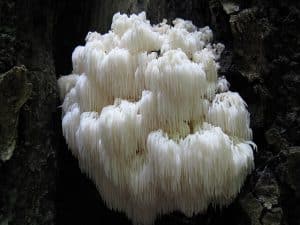
The Bear’s Head-Tooth mushroom is also known as the Western Coral Hedgehog mushroom. You may also see this fungus referred to as Monkey’s Head, Lion’s Mane, and a few other names. However, Bear’s Head-Tooth mushroom is actually in the same genus as Lion’s Mane mushroom, although it is technically a different species! Bear’s Head Tooth is composed of a mass of long spines that hang down and are an off-white color or pale yellow color. The fruit bodies often range between four and 30 inches tall and wide, often growing on conifer stumps. While this mushroom is edible, it should be cooked prior to consumption.
King Bolete (Boletus sp.)
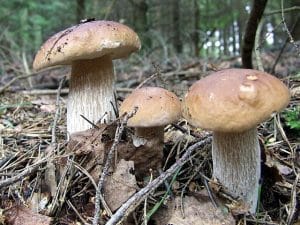
King Bolete mushrooms are also known as Penny Bun or Porcini mushrooms. This mushroom grows in deciduous and coniferous forests, yet is not the easiest mushroom to find, given that it is beloved and quickly eaten by wildlife. They produce spores and grow during the summer and autumn seasons. The body is comprised of a brown cap, averaging 12 inches in diameter, with an off-white stalk that reaches an average of eight inches tall. The King Bolete is difficult to cultivate and is one of the most sought-after wild edible mushrooms due to its texture and flavor.
Given the many forests and diverse weather patterns in New York, many fungi grow throughout the state, many of which are safe to eat. Start your foraging journey with these mushrooms and begin learning how to properly and safely forage wild edible mushrooms. There are still many more edible mushrooms to discover!






